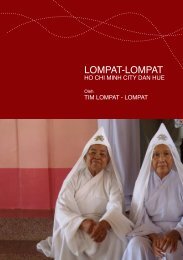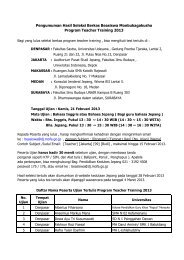9700_y16_sy
9700_y16_sy
9700_y16_sy
Create successful ePaper yourself
Turn your PDF publications into a flip-book with our unique Google optimized e-Paper software.
Cambridge International AS and A Level Biology <strong>9700</strong> <strong>sy</strong>llabus General <strong>sy</strong>llabus requirements and information<br />
Statistical tests<br />
Candidates should know when it is appropriate to use a statistical test. They should be able to use statistical<br />
tests to test for an association and know when to test for the significance of differences between samples.<br />
The chi-squared (χ 2 ) test is used to test the difference between observed and expected frequencies of<br />
nominal data. The chi-squared test allows the evaluation of the results of breeding experiments and some<br />
forms of ecological sampling. Chi-squared tests will only be expected on one row of data.<br />
The t-test is of value in much of biology to test for the significance of differences between two samples<br />
each with continuous data. This test should be used if:<br />
• continuous data has been collected<br />
• the data is from a population that is normally distributed<br />
• standard deviations are approximately the same<br />
• the two samples have fewer than 30 values each.<br />
Candidates should be able to use Pearson’s linear correlation to test for a correlation between two sets of<br />
normally-distributed data. The test should be used if:<br />
• continuous data has been collected<br />
• a scatter diagram indicates the possibility of a linear relationship<br />
• the data is from a population that is normally distributed<br />
• the number of paired observations should ideally be 10 or more, but the test can be used if there are at<br />
least 5.<br />
Spearman’s rank correlation is used to test for a correlation between two sets of data that are not<br />
distributed normally. The test should be used if:<br />
• data points within samples are independent of each other<br />
• ordinal data has been collected or the data that has been collected can be converted to an ordinal scale<br />
using ranking<br />
• a scatter diagram indicates the possibility of an increasing or a decreasing relationship<br />
• the number of paired observations should ideally be between 10 and 30 in total. The test can be used if<br />
there are more than 5<br />
• all individuals must be selected at random from a population; each individual must have an equal chance<br />
of being selected.<br />
For both Pearson’s linear correlation and Spearman’s rank correlation candidates should know that<br />
correlations exist between –1 (perfect negative correlation), 0 (no correlation) and +1 (perfect positive<br />
correlation).<br />
Candidates should also know that a correlation does not necessarily imply a causative relationship.<br />
These statistical methods are dealt with fully in many books and websites on statistics for biology.<br />
Candidates are not expected to remember the following equations and <strong>sy</strong>mbols. They are expected to be<br />
able to use the equations:<br />
• to calculate standard deviations, standard errors and 95% confidence intervals (which they may use for<br />
error bars on graphs)<br />
• to use the t-test to find out if there is a significant difference between the means of two small unpaired<br />
samples<br />
72 www.cie.org.uk/alevel Back to contents page





